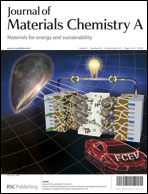Facile synthesis of Li4Ti5O12 nanosheets stacked by ultrathin nanoflakes for high performance lithium ion batteries
Abstract
Li4Ti5O12 nanosheets stacked by ultrathin nanoflakes derived from the interlayer splitting and exfoliation of the layered orthorhombic Li1.81H0.19Ti2O5·xH2O precursors are obtained by a facile method. The precursors are synthesized through a one-step, low-temperature hydrothermal method with a mixed solvent of ethanol and water. The surfactants and templates are free during the fabrication process. The ultrathin nanoflakes are interconnected and their thicknesses are only ∼3 nm. Possible morphology formation and crystal structure transition mechanisms are proposed through time-dependent experiments. As an anode material for rechargeable lithium-ion batteries, the Li4Ti5O12 nanosheets with a stacked structure delivered an initial discharge capacity of 175.9 mA h g−1, together with a discharge capacity of 166.8 mA h g−1 after 100 cycles at 0.5 C. The discharge capacity could reach up to 100.2 mA h g−1 even at 20 C. We infer that except for the self advantages of nanosheets as nanomaterials, the delicate structure consisted of stacks of interconnected ultrathin nanoflakes and can promote the kinetic property of lithium ions and electrons diffusion through offering more transporting channels, which is favorable for high-rate performance.


 Please wait while we load your content...
Please wait while we load your content...